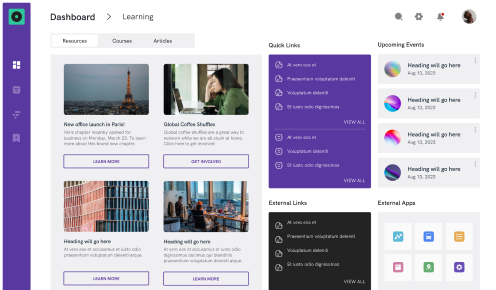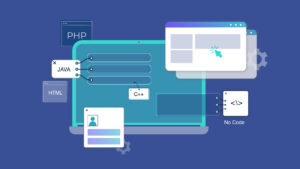The Future Vision of Enterprise Application
 By Apratim Ghosh
By Apratim Ghosh
 22nd January, 2021
22nd January, 2021
Next-Generation ERP
Enterprise App Innovations
Emerging Business Solutions
Next-gen Business Software
With sprawling digital adoption fueled by emerging technologies such as cloud and AI, the enterprise IT landscape will be largely modernized over the next three to five years. Even as business leaders continue to look to CIOs to provide technology-driven differentiation in the marketplace, the enterprise applications ecosystem and its stakeholders will face new challenges. The demand for personalized micro-capabilities will soar, driving the need for continuous and rapid innovation – at scale.
As buyers increasingly play a direct role and assume an upper hand in the technology life cycle process, they will significantly impact how platform vendors, service providers, and developer communities evolve.
Those who foresee upcoming trends and adapt faster will outperform. This blog explores how enterprise applications are expected to evolve in the future and the impact it’s likely to produce beyond technology – for businesses as well as consumers.
Six trends shaping the future of enterprise applications
As technology disruptions upend our long-held knowledge on the value and ownership of enterprise applications, six major trends will define the future:
1. Hyper-contextual, micro-capabilities will lead to mass personalization at scale:
With cloud becoming the first choice for enterprise applications, the technology architecture of the future will be largely standardized across customers, allowing minimal customizations. Micro capabilities are basically Microservices or microservices architecture including cloud native architectural approach in which a single application is composed of many loosely coupled and independently deployable smaller components, or services. However, the key differentiating aspect of implementations will be highly personalized, contextualized micro-capabilities. These will not be a result of hard-coded customizations but will rather come from two different aspects:
A. Cloud enterprise platforms’ capability to configure hyper-personalizationrelevant to customer’s market context and composable architecture,
B. The evolving Apps marketplace publishing micro-capabilities through APIs. This means horizontal capabilities will be differentiated from micro-vertical capabilities and last-mile digital solutions.Security, data privacy, and regulatory concerns will ease significantly giving way to multi-cloud adoptions, except for some sector-specific applications that may remain on-premises with specialized capabilities built for a purpose.
Multi-cloud adoption
2. AI predictability will drive the selection of micro-capabilities:
Product assessment will be replaced with an outcome-drivenselection from a pool of capabilities, instead of standard modules-based subscription. Once business KPIs and expected outcomes are finalized, the enterprise platform’s AI engine will provide recommendations of relevant micro-capabilities to choose from libraries, based on customer’s market context, industry best practices, adoption of the capabilities across the customer base, and their historical success. AI predictabilitywill also be measured against outcomes.
3. Agile enterprise applications will reign:
Most application vendors will provide in-built agility in the life cycle of product capabilities developed. Upgrade frequency and features’ selection will be customized at source, even on multi-tenant architecture. Going forward, closed-loop systems will emerge to integrate user feedback directly into the product innovation cycle in near real-time, bringing the application implementation cycle closer to agile product development.
Agile Methodology in application
4. Businesses will be free from vendor lock-in:
Standardized technology architecture will eliminate vendor lock-ins, enabling organizations to switch vendors without risking a major change in application configuration implemented. It will be possible to have multiple products seamlessly delivering different micro-capabilities of a particular function or process for a customer. The adopted capabilities are expected to be highly portable across various enterprise platforms.
5. Buyer’s market will emerge:
With less fear of vendor lock-in and high portability, application vendors will offer new try and buy models without requiring any commitment for upfront investments. More mature vendors are also likely to offer outcome-linked subscription models, giving customers both assurance and flexibility to pay only when the desired outcomes are achieved. Business capabilities may also be priced based on outcomes.
6. The business experience will take center stage:
With digitalization becoming the norm in all business functions, the business experiencewill become sacrosanct. System of records will no longer be simply transactional; rather it will acquire strategic importance, as customers gain more direct access to back-office data and information. Likewise, the system of engagements will be under pressure to measure CX in terms of tangible outcomes. Such systems will, therefore, collaborate more with back-office functions and external ecosystems to adapt at the pace of business change. A zero-touch user interface will become a reality.
Analytics driven CX approach
The transformational impact on ecosystem partners
Let’s understand how the shift in enterprise application development impacts the key ecosystem partners:
1. Apps Marketplace will play an important role in developing micro-capabilities and shaping the enterprise landscape. Business capabilities will be published by various marketplace players, developers, and the crowdsourced community, leveraging individual experiences. Their API-driven approach for different products will further boost hyper-personalization and flexibility for customers. For instance, Salesforce is known for its leading AppExchange platform, where thousands of ISVs and developers have built enterprise products such as Vlocity for Industry Cloud & FinancialForce for PSA solutions. Many more will emerge going forward.
2. Cloud Platform services will be key to providing flexibility and scalability to customers. Integration platforms will become more API-based. Data, content & collaboration platforms will offer consumption-based pricing. AI & Analytics platforms will deliver enterprise business use cases that will be priced on outcomes. Blockchain and IoT platforms will have bundled pricing by consortia or based on customer impact. Low code, no code features will become de facto.
API based integration platform
3. Service Providers will play a challenging role as a core integrator of business capabilities – by processes, persona, and business needs. Some providers will also build capabilities in the Apps Marketplace which may remain IP owned by either the service provider or jointly with the client. With the democratization of application development, emerging citizen developers, and the growth in the crowdsourced community, the application development role of system integrators (SI) will be limited.
However, service providers can emerge as a critical success partner for their clients as SIs will be largely looked upon as Advisors and Integrators who can assume the role of the true custodian of customers’ enterprise IT assets by leveraging multi-disciplinary teams with domain knowledge, experience design, and change management capabilities – all of which will assume higher importance. They will work closely with customers not only to implement business capabilities but also to assess best-of-breed application capabilities for their specific needs.
With increased technical debt due to legacy and fragmented cloud applications, architecture know-how will become a key differentiator. In an open enterprise, SIs will play a major role as orchestrators and channelize the consortia of Apps marketplace vendors, platform partners, and external services for their clients.
4. End customers will truly become Prosumers, directly influencing decisions related to products and service offerings, thanks to micro-capabilities offering hyper-personalization. Most customers will have personalized AI tools or assistants, and AI will be considered a new stakeholder that needs to be managed or influenced.
Human-Robot’s interaction or Cobots
5. Business users prefer role and persona-based application experiences that need higher personalization and context-driven functionalities. Cobot is one of its examples, where robots are intended for direct human-robot interaction within a shared place or work in proximity to humans. Cobots will be embedded into the applications, helping users with the automation of business workflows and physical actions together. Going forward, some business users will also become mature citizen developers. Take, for instance, Instabase that provides a platform and automation tooling to build cloud business applications. Many such platforms will emerge as a powerful marketplace providing numerous micro-capabilities that empower citizen developers and power users in DIY mode.
6. CIOs will shift focus from administering the IT landscape to attaining business outcomes and measuring the ROI of capabilities. With less fear of vendor lock-in and agile capabilities available at scale, IT will continue to act as a key enabler of business and IT architecture will become highly composable. With these changes, some of the business spend will shift from buying or managing enterprise platforms to partnering with advisors and integrators to drive superior outcomes.
We have already stepped into a new application-driven year, where enterprise applications will play the role of an innovative catalyst to drive the engine for business.
After knowing the above facts and benefits, it can be a question that where a business should get the proper enterprise application solutions for aligning the new tech approach with business goals. For them, Inovar consulting can be a fruitful solution with correct application-driven strategy and skillful resource. Check out how we have applied application strategy in our different projects and reach us for more information.
























